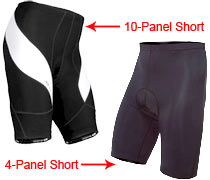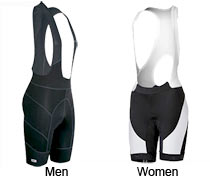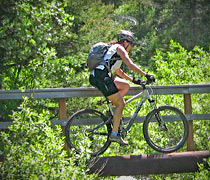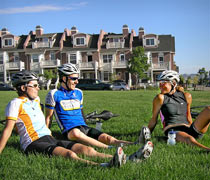Buyer's Guide To Lycra Cycling Shorts
 One of the easiest things you can do to maximize your riding comfort is getting bicycling shorts. These simple-looking pants are actually high-tech cycling gear with impressive features such as an anatomic fit, moisture-transferring fabrics, padding for top comfort and prevention against chafing and bacteria. That's why a few pairs of quality shorts should be an essential part of your cycling wardrobe.
One of the easiest things you can do to maximize your riding comfort is getting bicycling shorts. These simple-looking pants are actually high-tech cycling gear with impressive features such as an anatomic fit, moisture-transferring fabrics, padding for top comfort and prevention against chafing and bacteria. That's why a few pairs of quality shorts should be an essential part of your cycling wardrobe.
Today, companies around the globe manufacture bicycle shorts. Multiply this by the number of models each offers and there are thousands of bike shorts to choose from. Although all may look the same at first, there can be significant differences between models. To help you choose a great pair we've prepared the following shorts buyer's guide. And, keep in mind that while this article is about Lycra (spandex) cycling shorts, we also stock baggy shorts and knickers, which are fine options for a more casual appearance if that's what you prefer.
Men's and Women's Models
Men’s and women’s shorts differ in several ways. One big difference is the padding or chamois used in the crotch area. These are anatomically shaped and padded for each gender.
The other big difference is the cut from the hips to the waist. The small of a woman's back tapers to a narrower waist. As such, women's shorts have smaller waistbands and a more tapered fit just above the hips. In general, women are also longer waisted than men. So, most companies cut the front inseam longer in women's shorts.
The final difference is leg length. In general, women prefer a shorter leg length than the traditional men's short which is long enough to cover the quadriceps muscles (the long muscle in the thighs).
Understanding these basic differences will help you select shorts that fit and feel right to you. And, women, don't be afraid to cross gender lines. For example, if you're a larger woman built straight up and down, you may find men's shorts to be more comfortable than women's.
Construction & Materials
Cycling shorts are constructed of panels that contour the shorts to fit properly on your body when you're sitting on a bike seat, bent over slightly and pedaling. The more panels the shorts have, the more curvature they have, and usually the better they fit and more natural they feel. Though, with the stretch fabrics used in shorts today you can still get a nice fit in shorts with fewer panels.
Usually, high-end shorts have 8- to 10-panel designs. Some even have 12 panels. Less expensive shorts are usually 6-panel designs, which is still comfortable and supportive. Use of 4-panel designs is usually limited to workout clothing in which cyclists ride in a more upright position.
The panels in shorts are joined with seams that are flat to prevent chafing and ensure you're not sitting on raised seams that cause painful pressure points. There are also what's called "welded seams," a different process that creates a flat seam.
Another feature of many shorts is leg grippers. These are elastic bands at the bottom of the legs often with silicone on them that grip the thighs and keep the shorts from riding up while you're riding. There are different types of grippers and it's something to check out when you try on the shorts you're interesting in buying.
Standard Shorts or Bib Shorts?
While some Lycra cycling shorts are only available as standard shorts, most models are available in a bib design, too. So that’s a key choice to make in selecting new shorts. The difference is that the bib short has no real waist and instead relies on light, breathable elastic straps that go over your shoulders like suspenders to keep the short in place. These straps and the fabric that joins them in the front and rear comprise the bibs portion of the bib shorts. There are bib shorts for men and women.
Because there’s no constricting waist elastic in bib shorts, and because the straps keep the shorts in place, many riders feel that bib shorts offer superior freedom of movement and even more comfort than standard shorts.
Bib shorts are more expensive than standard models, though, and they are less convenient when nature calls. And, even though they breathe and are designed not to chafe, some cyclists may not like the feeling of the straps. Also, while it’s a light, thin layer, some may not want the extra fabric of the bibs on hot days.
The best approach is to find the model of shorts that you like and if they come in standard and bibs, try them both on to pick the winner. Or, if cost is an issue, go with the standard model as it will have all the same features minus the bibs so it will sell for less.
Fabric
Price points for cycling shorts are usually based on the fabric and pad that's used. Better materials usually cost more raising the price of the short.  Nylon spandex, the base for most cycling-short fabrics has great stretch and durability. However, nylon spandex does not transfer moisture (a major benefit when you're sweating) and breathe until a finish is applied, or until the fabric is knitted a special way.
Nylon spandex, the base for most cycling-short fabrics has great stretch and durability. However, nylon spandex does not transfer moisture (a major benefit when you're sweating) and breathe until a finish is applied, or until the fabric is knitted a special way.
So, spandex is now mixed with other yarns such as polyester to promote moisture transfer and breathability. And the design of the knit has distinct benefits too. Additionally, some fabrics claim to be more aerodynamic due to their dimpled mesh construction (the same idea behind a golf ball). While other designs have compression qualities, which rejuvenates muscles by promoting better blood circulation.
These special applications increase fabric pricing and are the main reason bike shorts come in such a wide price range. Be sure to ask if you have any questions about the fabrics and padding used in the shorts you're considering.
Padding (Chamois)
Believe it or not, in the early days of professional cycling, some racers, desperate for relief from saddle sores, actually put steaks in their shorts for padding! These days, a trip to the local market isn't necessary because bike shorts feature built-in protection.
This is usually called a "chamois" (say: "shammy"), because when it first appeared in shorts it was nothing more than a single layer of real leather chamois, similar to what you may use to wash and dry your car. And, it even had to be carefully maintained or it would dry out and crack.
Luckily, fabric technology and pad construction have improved incredibly over the years. And today, the pads inside shorts are more comfortable and functional than ever.
There are several different pad styles on the market and the fabric and construction of these styles vary greatly. It's important to understand that the main purpose of these pads is to provide a layer of protection against friction between you and your seat so there's no chafing, plus they transfer moisture so you stay dry. And, although the pads are generally thin, it's amazing the comfort improvement you get from the carefully placed padding. Also, the chamois is gender specific and the cut and padding is uniquely designed for men and women.
Most pads have several layers. The padding layer is usually made from foam or fleece and can differ greatly in thickness from thin (like the original natural leather chamois) to thick. The top layer is usually made of a technical fabric that transfers moisture, breathes, and prevents bacteria growth. Sometimes other fabrics are used, too.
Here again, trying on the shorts is the best way to tell which chamois feels best to you. Some riders prefer thick over thin and some go the other way, it's really up to you to decide.
Getting The Right Fit
As with all clothing, bike-short sizing varies from one company to the next. So, we recommend trying on several different shorts before buying. Fabrics and construction will cause each short to fit differently.
Also, when trying on cycling apparel, put yourself in a cycling position. You don't ride the bike standing straight up and down, after all. Cycling shorts should fit like a second skin, snug and comfortable with no bagging or wrinkles.
Leg Length
Leg lengths vary anywhere from 3 to 10 1/2 inches. Traditional wool racing shorts were usually cut long so that the fabric covered the quadriceps muscle, keeping the short from riding up into the crotch and chafing. The advent of stretch fabrics and elastic leg grippers, however, has allowed manufacturers to make shorter shorts without compromising function.
Shorts length can be divided into three categories based on leg length:
Short (3 - 5 inches): "hot pants" length (usually designed for cross-training, spinning and triathlons)
Medium (6 - 8 inches): average cycling short length
Long (9 - 11 inches): past the quadriceps (usually a European-cut racing length)
Waistbands
Waistbands range from a 1/2-inch covered elastic to an 1 1/2-inch athletic waistband with a drawstring. The major consideration is comfort. Be sure to bend over into the cycling position when you try on cycling shorts to see how the waistband will feel on the bike. If you have a belly and don't like the feel of elastic around your waist, try bib shorts, which don't have elastic waists.
Final Tips
Never wear underwear under your bike shorts. One reason is that the materials used in the chamois pads in cycling shorts today are designed to transfer moisture, breathe and prevent bacteria growth. This means bike shorts are much more sanitary than your underwear. And equally important, cycling shorts have flat seams to provent chafing, unlike underwear that has seams that can cause chafing and pressure points.
Additionally, the whole purpose of the cycling short's pad is to prevent chafing. In order to work, the short must fit your body like a second skin. Having a layer of clothing between your body and your shorts prevents the shorts from working the way they should, and increases your chances of experiencing chafing and sores where the underwear sits against your body.
Having a layer of clothing between your body and your shorts prevents the shorts from working the way they should, and increases your chances of experiencing chafing and sores where the underwear sits against your body.
As a final tip, if you ride regularly, you'll probably find that it's best to have at least two pairs of riding shorts because that way, you'll always have a clean pair to ride in.
We hope this guide helps you pick out a great new pair of cycling shorts. Feel free to surf around our website. And, please contact us if you have questions about anything in this article or anything else bicycle related.
Be sure to visit our store, too, where you can see all our bicycle clothing, bikes, components and accessories up close and personal. Thanks for reading!
